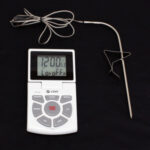Not a child exists that will never get at least a mild fever. Most infants and toddlers get frequent fevers for varying reasons and these sudden elevations in body temperature can worry parents to no end. However the majority of infants and toddlers get over their fevers without any ill effects.
Checking to see if a small child has a fever can be a real challenge. If you are using the old-fashioned rectal thermometer, it pays to learn how to do it right. The best positions for this method are with the baby on his stomach, bottom in the air, or on his side. You should be able to steady him with one hand while inserting the well-lubricated thermometer about half an inch into his anus. This method takes the longest and is extremely difficult once the child is old enough to wriggle out from under you! Under the arm is another way to use this thermometer, but it is also difficult.
Far easier is the ear thermometer. This is simply held in the baby’s ear and a button pushed. Within seconds, you have the internal temperature, and it is easy and painless. You can also use a thermometer strip which is held against the child’s forehead and uses marked segments to give the temperature. If you get a high reading, it is best to check it with one of the other methods to be sure.
When evaluating fevers in infants and toddlers, age is a major consideration. Any fever in a baby less than three months old is cause for concern, unless it is immediately after getting a vaccination, in which case this is a normal immune reaction. A call to the doctor is warranted with any other high temperature in a newborn.
In babies, a low temperature might mean that the infant is overdressed. Babies have troubles regulating their body temperature, so removing some clothing might be the solution to the problem.
In infants and toddlers, any temperature over 100º F is considered a fever. Low-grade fevers aren’t usually dangerous unless they continue for more than a couple of days. These types of fevers can be caused by a cold or flu and are sometimes associated with teething. In these cases, infants and toddlers can be given a dose of Tylenol and their temperature will go back to normal. It is simply a sign that the immune system is working.
With older infants and toddlers, a fever over 102º can be cause for concern, but you should also take into account the child’s behavior. If he is suddenly listless and crying or uninterested in toys and games that usually delight him, the fever is probably serious and you should call your pediatrician. However, if the child has a fever and is still playing and laughing, you can probably treat it safely with infant Tylenol and just keep an eye on him.
Fevers in infants and toddlers can be scary, but as a parent you have a natural intuition. You know if your child is really sick or not, despite the reading on the thermometer. Trust your instincts.





